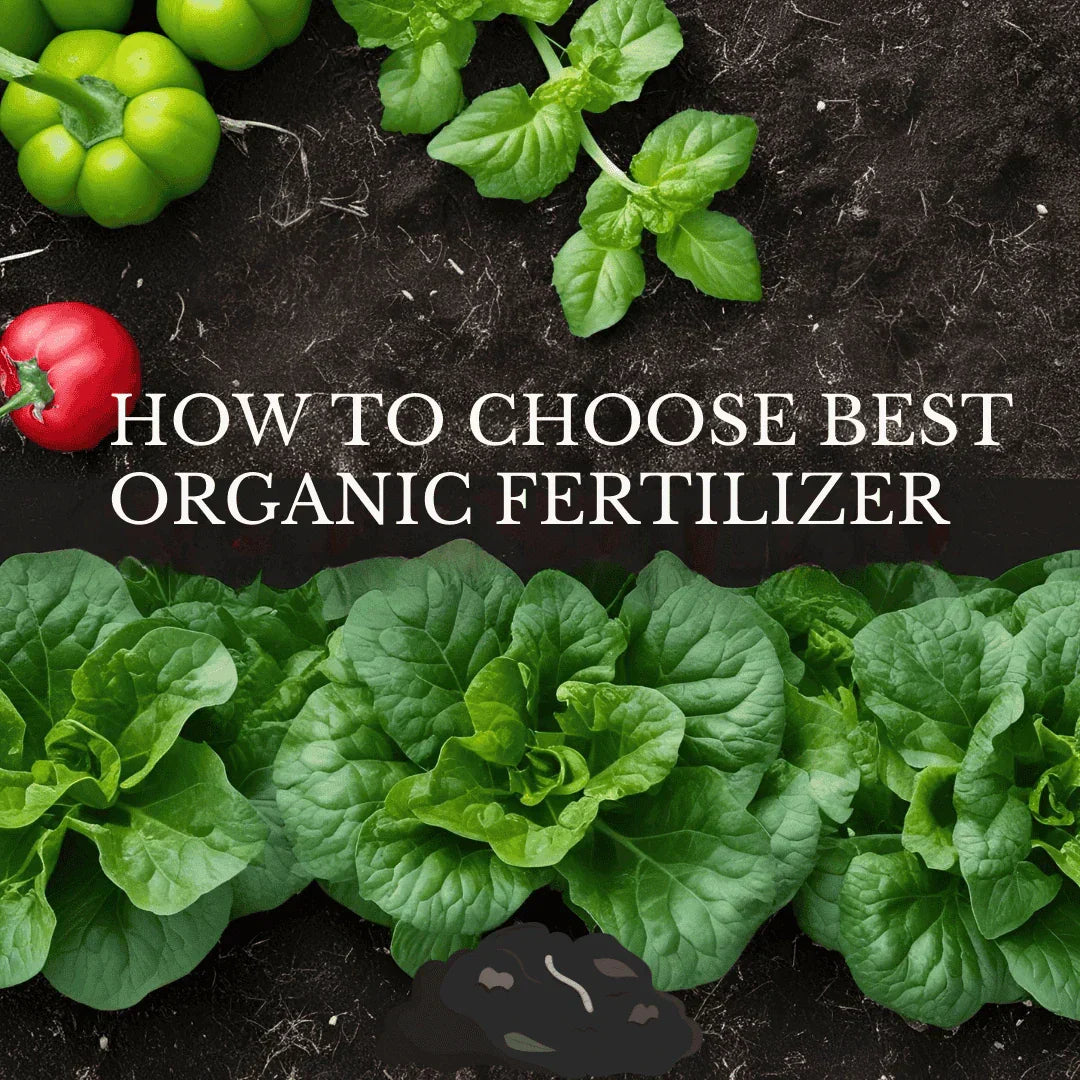
How To Choose The Best Organic Fertilizer
Organic fertilizers play a vital role in creating a thriving garden that is both productive and sustainable. Choosing the best organic fertilizer is essential for vibrant plant growth, strong root systems, and a resilient garden ecosystem. The wrong choice can lead to poor plant performance, wasted effort, or even damaged soil.
In this blog, you’ll learn what organic fertilizers are, their benefits, the different types available, how to select the best one for your garden, and how to apply them effectively.
What is Organic Fertilizer
Organic fertilizers are natural substances derived from plant, animal, or mineral sources. Unlike synthetic fertilizers, they release nutrients slowly as they break down in the soil, promoting long-term soil health and sustainability.
Benefits of Organic Fertilizer:
- Improves soil structure and fertility over time resulting in higher yields.
- Enhances water retention, especially in sandy soils
- Feeds beneficial microbes that support healthy plant growth
- Eco-friendly and renewable, reducing chemical runoff
- Promotes long-term plant health with slow nutrient release
- Safe for edible plants, pets, and the environment
- Reduces dependence on synthetic chemicals and fossil fuels
How to Choose the Best Organic Fertilizer
1. Know Your Soil
Start by testing your soil’s pH and nutrient levels. A soil test tells you what your soil already has—and what it lacks. This helps prevent over-fertilization or wasting time and money on nutrients your plants don’t need. You can use a home soil test kit or send a sample to a local extension service.

2. Identify Your Plants’ Needs
Not all plants require the same nutrients.
- Leafy greens like lettuce and spinach crave nitrogen to fuel lush foliage.
- Root vegetables such as carrots or beets need more phosphorus for strong root development.
- Flowering and fruiting plants thrive with a boost of potassium and phosphorus to support blooms and fruit.
Understanding your plants’ specific needs will help you choose a fertilizer that supports their growth goals.
3. Consider the Growth Stage
Plants need different nutrients at different stages of growth.
- Seedlings and young plants benefit from fast-acting, easily absorbed fertilizers like fish emulsion or diluted compost tea.
- Established or mature plants often do better with slow-release fertilizers like bone meal or compost that nourish over time.
Tailoring your fertilizer choice to the plant’s life stage ensures healthier, more balanced growth.
4. Check the Nutrient Composition (NPK Ratio)
Look for the N-P-K numbers on fertilizer packaging. These stand for:
- N = Nitrogen (leafy growth)
- P = Phosphorus (root development and flowering)
- K = Potassium (overall health and resistance)
Match the NPK values to your gardening goals. For example:
- A fertilizer labeled 10-5-5 is high in nitrogen—perfect for green, leafy plants.
- A 4-10-10 mix works well for flowers and fruiting plants.

5. Match Fertilizer to Your Soil Type
Different soils absorb and retain nutrients differently.
- Sandy soils drain quickly and may benefit from compost or manure to retain moisture and add structure.
- Clay soils hold water but can become compacted. Worm castings or gypsum-based organic blends can improve aeration and drainage.
Knowing your soil texture helps you pick a fertilizer that complements and improves it.
6. Prioritize Sustainability
Opt for fertilizers made from renewable, biodegradable, or locally sourced materials.
- Compost, manure, and worm castings are low-impact and often available from nearby farms or suppliers.
- Avoid fertilizers with unnecessary additives or packaging waste.
Choosing eco-friendly options not only helps your garden—it supports the planet too.
7. Consider the Application Method
Organic fertilizers come in several forms—choose the one that fits your gardening style:
- Liquid fertilizers are fast-acting and perfect for container plants or foliar feeding.
- Granules and powders are ideal for garden beds and offer longer-lasting nourishment.
- Compost and manure are great for working into soil or top-dressing.
Select a format that fits your time, tools, and the size of your garden.

8. Look for Organic Certification
If you’re growing food crops, especially organically, certification matters.
- Look for labels like OMRI Listed (Organic Materials Review Institute) or USDA Organic.
- Certified fertilizers meet safety standards and don’t contain synthetic additives, ensuring your garden stays truly organic.
Types of Organic Fertilizers
1. Compost
Compost is made from decomposed kitchen scraps, yard waste, and manure. It turns into a dark, soil-like material rich in nutrients. Compost improves soil health, helps it hold water, and feeds your plants naturally—no synthetic chemicals needed. There are several types of compost bins available to suit any garden size or style.

2. Manure
Manure comes from animal waste like cows, chickens, horses, and sheep. It contains essential nutrients like nitrogen, phosphorus, and potassium. Aged or composted manure is best, as it’s safer and doesn’t carry weed seeds. It’s a natural way to boost soil fertility.
3. Bone Meal
Bone meal is made from ground animal bones. It's full of phosphorus and calcium, which help roots grow strong and support flowering. It's slow-releasing, making it great for bulbs, fruits, and veggies.
4. Fish Emulsion
Fish emulsion is a liquid fertilizer made from fish leftovers. It’s packed with nitrogen and is quickly absorbed by plants, encouraging fast growth and lush greenery. It also improves soil life and works well for most types of plants.
5. Blood Meal
Blood meal is a powerful nitrogen-rich fertilizer made from dried animal blood. It promotes leafy growth, especially for greens like spinach or lettuce. Use it carefully—too much nitrogen can harm your plants.
6. Worm Castings
Also known as “black gold,” worm castings are the waste produced by earthworms. They’re full of nutrients and good microbes. They improve soil structure, help hold moisture, and support healthy plant growth.
7. Volcanic Rock Dust
This fertilizer comes from ground volcanic rock and is packed with trace minerals like iron, magnesium, and calcium. It slowly enriches tired soil, strengthens roots, and can improve the flavor and quality of your crops.

How to Apply Organic Fertilizers
Read the Label and Instructions
Before using any organic fertilizer, always read the application guidelines. Organic fertilizers vary in strength and nutrient content, so understanding dosage and frequency is crucial. Over-fertilizing—even with organic products—can stress or harm plants.
Apply at the Right Time
Timing matters. Here’s when to apply organic fertilizers for best results:
-
At planting time – Mix compost, bone meal, or worm castings into the soil before planting to enrich it.
-
During the growing season – Use liquid fertilizers like fish emulsion or compost tea for a quick nutrient boost.
-
Before flowering or fruiting – Apply phosphorus-rich fertilizers to encourage strong blooms and healthy fruit.
Tip: Fertilize early in the morning or late in the afternoon to avoid scorching plants in direct sunlight.
Choose the Right Application Method
There are several ways to apply organic fertilizer depending on the form and purpose:
Top-Dressing: Sprinkle dry fertilizer (like compost, worm castings, or powdered bone meal) directly onto the soil around the base of your plants. Lightly mix it into the top inch of soil and water well.
Side-Dressing: For growing plants, dig a shallow trench a few inches away from the stem and apply fertilizer there. This method keeps nutrients close to the root zone without direct contact with stems.
Incorporation (Pre-Planting): Work granular or composted fertilizers into the soil before planting. This ensures nutrients are evenly distributed and accessible to roots.
Liquid Feeding (Foliar or Soil Drench)
Dilute liquid fertilizers (like fish emulsion or compost tea) and either:
-
Drench the soil around plant bases.
- Spray directly onto leaves for foliar feeding—ideal for quick absorption of micronutrients.
Water After Application
Watering after applying dry fertilizers helps nutrients soak into the soil and reach plant roots. For liquid applications, make sure leaves dry before nightfall to prevent disease.
Reapply as Needed
Organic fertilizers break down slowly, so reapplication is needed throughout the season. Follow product guidelines for timing—many need reapplication every 3–6 weeks, depending on plant type and soil conditions.
Conclusion
Choosing the right organic fertilizer is key to a thriving, sustainable garden. It ensures healthy plant growth, robust root systems, and a vibrant soil ecosystem.
Test your soil, understand your plant’s needs, and select organic fertilizers that match your garden’s goals. With the right approach, your garden will not only grow—it will thrive.
Discover more ways to boost your garden’s health and productivity. Check out our blog for expert advice on everything from organic fertilizers to plant care and garden design. Start growing your dream garden today!
